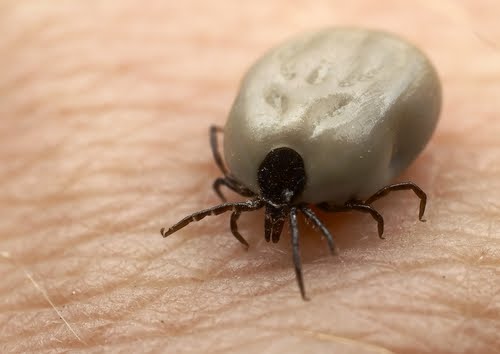CDC Introduces Tickborne Diseases App for iOS and Android devices
http://content.govdelivery.com/accounts/USCDC/bulletins/101d1f4
Centers for Disease Control and Prevention (CDC) sent this bulletin at 05/05/2015 02:15 PM EDTThe Centers for Disease Control and Prevention is pleased to announce the release of the Tickborne Diseases of the United States app at:
http://www.cdc.gov/mobile/applications/MobileFramework/tickborne-diseases.html
This app provides a quick reference for doctors and other health care providers who may diagnose and treat tickborne diseases, including information to help:
- Identify ticks and the pathogens that each species can transmit
- Determine which tickborne diseases are most common in your area
- Identify signs and symptoms of tickborne diseases and order the appropriate lab tests
- Properly treat the most common tickborne diseases
A Reference Manual for Health Care Providers, available as a pdf at:
http://www.cdc.gov/lyme/resources/tickbornediseases.pdf
App content updates automatically when your device is connected to a network, so you're always up-to-date.
In addition, you can personalize the app with features like highlighting, annotations, and bookmarks.
http://www.cdc.gov/mobile/applications/MobileFramework/tickborne-diseases.html
Tick-Borne Relapsing Fever (TBRF):
http://www.cdc.gov/relapsing-fever
TBRF Distribution (Geographic):
http://www.cdc.gov/relapsing-fever/distribution
TBRF Transmission:
http://www.cdc.gov/relapsing-fever/transmission
TBRF Symptoms:
http://www.cdc.gov/relapsing-fever/symptoms
PREVENTION OF TICK BITES ON PEOPLE:
http://www.cdc.gov/ticks/avoid/on_people.html
PREVENTION OF TICK BITES ON PETS:
http://www.cdc.gov/ticks/avoid/on_pets.html
PREVENTION OF TICKS IN THE YARD OF ONE'S HOME:
http://www.cdc.gov/ticks/avoid/in_the_yard.html
REMOVING A TICK:
http://www.cdc.gov/ticks/removing_a_tick.html
SYMPTOMS OF TICK-BORNE ILLNESS - GENERAL:
http://www.cdc.gov/ticks/symptoms.html
GEOGRAPHIC DISTRIBUTION OF TICKS (with photos & maps):
http://www.cdc.gov/ticks/geographic_distribution.html
Rocky Mountain Spotted Fever (RMSF) - A Tickborne Disease:
http://www.cdc.gov/rmsf
Rocky Mountain spotted fever (RMSF) is a tickborne disease caused by the bacterium Rickettsia rickettsii. This organism is a cause of potentially fatal human illness in North and South America, and is transmitted to humans by the bite of infected tick species.
In the United States, these include the American dog tick (Dermacentor variabilis), Rocky Mountain wood tick (Dermacentor andersoni), and brown dog tick (Rhipicephalus sanguineus).
Typical symptoms include: fever, headache, abdominal pain, vomiting, and muscle pain. A rash may also develop, but is often absent in the first few days, and in some patients, never develops.
Rocky Mountain spotted fever can be a severe or even fatal illness if not treated in the first few days of symptoms. Doxycycline is the first line treatment for adults and children of all ages, and is most effective if started before the fifth day of symptoms.
The initial diagnosis is made based on clinical signs and symptoms, and medical history, and can later be confirmed by using specialized lab tests. RMSF and other tickborne diseases can be prevented.
p.s. I knew a man who was diabetic, contracted Rocky Mountain Spotted Fever (RMSF).
He was hospitalized over 2 weeks and nearly died from it!!!
Tickborne Diseases of the U.S.:
http://www.cdc.gov/ticks/diseases/index.html
In the United States, some ticks carry pathogens that can cause human disease, including:- Anaplasmosis is transmitted to humans by tick bites primarily from the blacklegged tick (Ixodes scapularis) in the northeastern and upper midwestern U.S. and the western blacklegged tick (Ixodes pacificus) along the Pacific coast.
- Babesiosis is caused by microscopic parasites that infect red blood cells. Most human cases of babesiosis in the U.S. are caused by Babesia microti. Babesia microti is transmitted by the blacklegged tick (Ixodes scapularis) and is found primarily in the northeast and upper midwest.
- Borrelia miyamotoi infection has recently been described as a cause of illness in the U.S. It is transmitted by the blacklegged tick (Ixodes scapularis) and has a range similar to that of Lyme disease.
- Colorado tick fever is caused by a virus transmitted by the Rocky Mountain wood tick (Dermacentor andersoni). It occurs in the the Rocky Mountain states at elevations of 4,000 to 10,500 feet.
- Ehrlichiosis is transmitted to humans by the lone star tick (Ambylomma americanum), found primarily in the southcentral and eastern U.S.
- Heartland virus infection has been identified in eight patients in Missouri and Tennessee as of March 2014. Studies suggest that Lone Star ticks may transmit the virus. It is unknown if the virus may be found in other areas of the U.S.
- Lyme disease is transmitted by the blacklegged tick (Ixodes scapularis) in the northeastern U.S. and upper midwestern U.S. and the western blacklegged tick (Ixodes pacificus) along the Pacific coast.
- Powassan disease is transmitted by the blacklegged tick (Ixodes scapularis) and the groundhog tick (Ixodes cookei). Cases have been reported primarily from northeastern states and the Great Lakes region.
- Rickettsia parkeri rickettsiosis is transmitted to humans by the Gulf Coast tick (Amblyomma maculatum).
- Rocky Mountain spotted fever (RMSF) is transmitted by the American dog tick (Dermacentor variabilis), Rocky Mountain wood tick (Dermacentor andersoni), and the brown dog tick (Rhipicephalus sangunineus) in the U.S. The brown dog tick and other tick species are associated with RMSF in Central and South America.
- STARI (Southern tick-associated rash illness) is transmitted via bites from the lone star tick (Ambylomma americanum), found in the southeastern and eastern U.S.
- Tickborne relapsing fever (TBRF) is transmitted to humans through the bite of infected soft ticks. TBRF has been reported in 15 states: Arizona, California, Colorado, Idaho, Kansas, Montana, Nevada, New Mexico, Ohio, Oklahoma, Oregon, Texas, Utah, Washington, and Wyoming and is associated with sleeping in rustic cabins and vacation homes.
- Tularemia is transmitted to humans by the dog tick (Dermacentor variabilis), the wood tick (Dermacentor andersoni), and the lone star tick (Amblyomma americanum). Tularemia occurs throughout the U.S.
- 364D rickettsiosis (Rickettsia phillipi, proposed) is transmitted to humans by the Pacific Coast tick (Dermacentor occidentalis ticks). This is a new disease that has been found in California.
